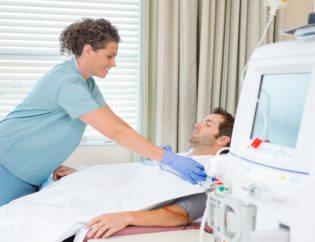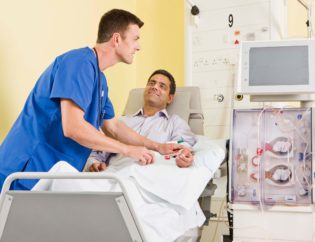
The type of dialysis treatment the patient is receiving will also factor into emergencies. Peritoneal dialysis requires personal training and commitment since, in most cases, patients can administer treatments by themselves. Hemodialysis involves nurses and trained professionals doing the dialysis treatments. There are risk factors to both types. Dialysis nursing involves paying close attention to signs that indicate emergency dialysis is necessary. Here are five of those.
1. Excess Fluid in the Lungs
Excessive fluids in the cardiovascular system can cause pulmonary edema, also known as wet lung. If this happens, it is a medical emergency. Pulmonary edema can develop in a dialysis patient for many reasons including missed dialysis treatments, excessive salt and fluids intake, and uncontrolled hypertension. The patient should be under regularly supervision to check for excess fluid.
2. Unusual Dry Weight Levels
Dry weight is the patient’s weight without the fluids that accumulate between dialysis sessions. It can be compared to the weight a person with normal functioning kidneys would weigh after urinating. Failing to achieve an acceptable dry weight can put a dialysis patient at a risk to develop issues. Excessive dry weight levels can raise blood pressure, cause lungs to fill with fluid, and other emergency symptoms. An unusual dry weight may be a sign emergency dialysis is necessary.
3. High Levels of Electrolyte Potassium in the Blood
Hyperkalemia, or high amounts of electrolyte potassium in the blood, is a common emergency indicator. Some symptoms of hyperkalemia include chest pain, shortness of breath, vomiting, and heart palpitations. If your patient is experiencing any of these conditions then they may need emergency dialysis. Patients with renal-failure-associated hyperkalemia are qualified to receive emergent dialysis therapy.
It is crucial to take seriously electrolyte emergencies since they can be lethal. It is also important to note the difference between hyperkalemia and hemolysis. Hemolysis is a false indicator of raised electrolyte levels that should be managed differently. There are other electrolyte disorders similar to hyperkalemia that can be just as troublesome.
4. Access-related Issues
Catheters go inside the abdomen of the patient during dialysis treatments. Therefore, sometimes an emergency can occur at the catheter site. Patients may experience infections that cause swelling and discharge at this location. An infection usually makes the patient ill and will require that the catheter be removed. Emergency dialysis may also be necessary. Bleeding and other issues may arise during this removal process.
5. Pain
Abrupt or uncommon pain could be a sign emergency dialysis is needed. This depends on the overall health and regular experience of the patient. The treatment of the pain is what will determine if emergency dialysis is needed. Pain is a common symptom of kidney disease and the resulting dialysis, and a considerable amount of dialysis patients receive pain medications.
The dosages of drugs used to treat pain in dialysis patients should be monitored closely by the nurses. A wide range of medications is prescribed, from over-the-counter acetaminophen to prescribed opioids like oxycodone. These powerful drugs must be used with caution so that they help rather than harm.
Emergency dialysis can be nerve-wracking to conduct, and it requires capable a dialysis nurse. There is currently a huge demand for nurses in this field. If you are seeking opportunities to become a dialysis nurse, check out the New Directions Staffing website.











